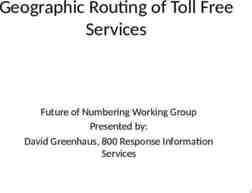Social Care: Safeguarding Across Transitions Dez Holmes
22 Slides3.14 MB
Social Care: Safeguarding Across Transitions Dez Holmes Director, Research in Practice
Social Care: Safeguarding Across Transitions Dez Holmes Director Research in Practice @dez holmes
The case for change Adolescents may have distinct safeguarding needs, harms - and routes to protection - are often 'contextual‘ / extra-familial and are underpinned by complex social and biological drivers Harm and its effects do not abruptly end at 18; support may do Transition to adulthood is a particularly challenging and vulnerable time, we may need care and support without having Care & Support needs Need to consider promoting resilience and their changing developmental needs There are moral and economic drivers for a reimagined safeguarding system which is contextual, transitional and relational.
As Chief Execs, you know “People’s problems transcend services; unsurprisingly, they won’t be remedied through individual services, or directorates, acting in isolation. As our corporate plan makes clear, successfully solving the problems people face is unlikely to be within the gift of the council alone. The nature of the problems faced by the council and our partners requires a different approach. A focus on long-term, preventative interventions will require a different, collaborative approach that brings together partners from the public, private and voluntary sectors, as well as wider civil society. This isn’t, yet, our default way of working.” (Niall Bolger, Chief Executive, London Borough of Hounslow)
It’s a system thing Have we defined our goals correctly to optimise the whole system? Do we have joined-up systems analysis, paying attention to dynamics, or are we lost in static data? Are we avoiding creating irreversible emphasis? Are we paying enough attention to the potential side-effects of our actions? Are we avoiding over-steering or over-reacting? Are we avoiding authoritarian action? How can we act with humility & future consciousness, applying foresight & transformative innovation in the face of the unpredictability & uncontrollability of complex dynamic systems? https://medium.com/age-of-awareness/how-can-we-participate-appropriately-in-complex-systems-aec17e74c d9f
(Godar & Holmes, 2017)
It’s about relationships To develop normally, a child* requires progressively more complex joint activity with one or more adults who have an irrational emotional relationship with the child. Somebody’s got to be crazy about the kid. That’s number one. First, last, and always. *person! (Bronfenbrenner, 1971)
If we designed from scratch ? Evidence-informed Contextual* / ecological Transitional / developmental Relational Harms, risks and protective factors Assessment, intervention Place-based approach Developmental perspective Fluidity over time Requires alignment of systems Person-centred Relationships as vehicle & intervention Capacity building Trauma-attuned Equalities, Diversity & Inclusion Participative (see Firmin’s work - https://contextualsafeguarding.org.uk/)
Complex, contemporary risk – and ever-evolving Emerging agency and our conflicted notion of choice / autonomy makes teenagers ‘imperfect victims’ (Rees and Stein, 1999) Working within a child protection system that is designed primarily to meet the needs of younger children maltreated within the family (Bilston, 2006) Recognised (healthy?) tension re adults’ autonomy / capacity and the societal imperative to enable people to be safe whatever their ‘entitlements’.
Structural factors require connected systems Poverty shown to have a strong causal effect on physical and mental health (Marmot and Bell, 2012) and is linked to child protection and care rates Poverty linked to SE of adults; increases psychological distress and reduces opportunities for employment (Wilson and Butler, 2013) SE can compound mental ill-health for many adults, and MH issues arising from sexual exploitation can result in diagnoses of PTSD, (Levine, 2016) Connection between modern slavery (including forced labour, sexual exploitation and trafficking) and homelessness (bi-directional) (The Passage, 2017) Adults who are termed as having multiple needs and exclusions are known to experience a range of negative outcomes and are more likely to have experienced adversity in childhood (McDonagh, 2011; RiPfA, 2015) Interconnectedness of these harms and adversities requires a highly integrated system of support, operating from a lifespan perspective.
Redefining adolescence and transition Some studies into brain development and effects on behaviour show some elements of brain growth – eg development to more mature affect regulation, social relationships and executive functioning - continue into the 20s (Sawyer et al, 2018) “An expanded and more inclusive definition of adolescence is essential for developmentally appropriate framing of laws, social policies, and service systems. Rather than age 10–19 years, a definition of 10–24 years corresponds more closely to adolescent growth and popular understandings of this life phase” (Sawyer et al, 2018) BUT biological studies to define capabilities of adolescents should be treated with caution, not misinterpreted in reductionist ways (Moshman, 1999).
Mind the gap Child protection (‘rescuing babies from harm in the family’) Making Safeguarding Personal (‘Person-led, risk-enablement, choice & control’)
Learning disability Comms impairment ADHD Autistic Spectrum Disorder Any head injury Head injury (LoC) Vulnerability & YJ population YP in general population YP in custody 2–4% 23–32% 5–7% 60–90% 1.7–9% 12% 0.6–1.2% 15% 24–42% 49–72% 5–24% 32–50% (Justice Select Committee, 2016) Young adults involved in the CJS have often themselves been victims of crime. Many have a history of being exposed to violence, including in the home, abuse, neglect, bereavement relating to the deaths of parents, siblings and other close relatives, and criminal behaviour by parents and siblings. These traumatic events have frequently occurred from a very young age and, the traumatic effects may be raw.
Image: http://ourvoiceteen.blogspot.co.uk/2012/06/my-teenage-brain-takes-that-as-insult.html
People’s ‘choices’ and ‘risk-taking’ behaviours Young people’s ‘risk-taking’ - underpinned by interacting biological, social, environmental and neurobiological changes (Calkins, 2010) Risk can be positive (Coleman, 2014) Ego-syntonic risks Adapted to harms experienced in earlier childhood Unmet needs - seek to meet via risky routes Misinterpreted as rational informed ‘lifestyle choices’ Victims being denied appropriate support / permission to give up Conversely, professionals can minimise people’s choice and agency
I was in care all my life and you did keep me really safe. You wrapped me up tight in bubble wrap but I’m 19 now and I kind of feel like I can’t move my arms Now I’ve left care I get really lonely. That’s a big thing for my safety I think, but no one talks about it as safeguarding. Unless you’re worried about my child, I won’t hear from you [children’s services] again. (Aisha, care-experienced young adult) (Max, care-experienced young adult) I couldn’t wait to get to 18, I thought that once I was an adult everything would change. It hasn’t worked out that way. I really wish I was a kid again so that you could lock me up. (Kelly, young adult)
What could we do? Deliberative learning from other services and parts of the wider system where transitional approaches are more embedded ‘drawing down’ best practice from safeguarding adults into safeguarding adolescents: rightsbased approaches, MSP, wellbeing focus Considering how Contextual Safeguarding and Complex Safeguarding and other innovations in children’s safeguarding might inform safeguarding of young adults: place-based, partnership approach Reflect on how safeguarding responses can overlook – even exacerbate – vulnerability Iatrogenic interventions? Build up local capacity for system redesign, cost-benefit analysis and boundary-spanning problem solving
Resilience & participation Relationships are paramount to promoting resilience (Coleman, 2014) Self-efficacy - commonly associated with resilience, are areas that professionals can exercise some influence Children's rights to protection and participation are mutually dependent and indivisible (UNCRC) “[User] Involvement supports development of effective safeguarding practice, informed by people whose self-confidence, self-esteem and resilience can be developed through that involvement.” (Droy & Lawson, 2017)
Money matters The current approach isn’t great value Preoccupation with thresholds at the expense of prevention Ceasing safeguarding support at 18, does not mean these young people cease to require resource Investing in preventative and recovery-oriented work to promote people’s safety and wellbeing can play an important role in avoiding the costs of later intervention Evidence from the UK and international contexts suggests that failing to help young people recover from harm and trauma can mean that problems persist and/or worsen in adulthood, creating higher costs for the public purse (Chowdry and Fitzsimons, 2016; Kezelman et al, 2015) Adults facing multiple problems and adversities can find services are not able to meet their needs effectively, meaning this group of adults ‘end up living chaotic and expensive lives’ (see MEAM Network)
Transitional Binary notions of childhood and adulthood are increasingly hard to justify Safeguarding Many environmental / structural factors that increase children’s vulnerability persist into adulthood, resulting in unmet need Investing in preventative work to promote people’s safety and wellbeing can play an important role in avoiding costs of later intervention Resilience, self-efficacy, social connectedness – all key to wellbeing – invites relational practice (and concordant policy) Does not propose all young adults should be protected via statutory means, nor does it propose a paternalistic approach to safeguarding young adults Innovation in this area may not depend on changes to legislation and/or statutory guidance ‘Whole person whole place’ approaches rely on visionary leaders If not now, then when?
Thank you www.rip.org.uk @researchIP www.ripfa.org.uk @ripfa



























